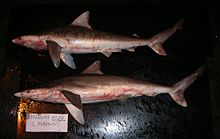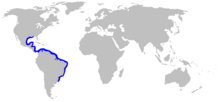| Smalltail shark | |
|---|---|

| |
| Scientific classification | |
| Domain: | Eukaryota |
| Kingdom: | Animalia |
| Phylum: | Chordata |
| Class: | Chondrichthyes |
| Subclass: | Elasmobranchii |
| Order: | Carcharhiniformes |
| Family: | Carcharhinidae |
| Genus: | Carcharhinus |
| Species: | C. porosus
|
| Binomial name | |
| Carcharhinus porosus (Ranzani, 1839)
| |

| |
| Range of the smalltail shark[1][2] | |
| Synonyms | |
|
Carcharias henlei Müller & Henle, 1839
| |
The smalltail shark (Carcharhinus porosus) is a species of requiem shark, and part of the family Carcharhinidae. It is found in the western Atlantic Ocean, from the northern Gulf of Mexico to southern Brazil. It inhabits shallow waters close to shore, particularly over muddy bottoms around estuaries. It tends to swim low in the water column and forms large aggregations segregated by sex. A slim species generally not exceeding 1.1 m (3.6 ft) in length, the smalltail shark has a rather long, pointed snout, a broad, triangular first dorsal fin, and a second dorsal fin that originates over the midpoint of the anal fin base. It is plain gray in color, without prominent markings on its fins.
The diet of the smalltail shark consists mainly of bony fishes such as croakers, while crustaceans, cephalopods, and smaller sharks and rays may also be consumed. It is viviparous, meaning the developing embryos are sustained by a placental connection. Females bear litters of two to 9 young on a biennial cycle, following a roughly 12-month gestation period. The smalltail shark is often caught as bycatch and may be used for meat, fins, liver oil, cartilage, and fishmeal. It seems to have declined significantly since the 1980s. Therefore, the International Union for Conservation of Nature has listed it as critically endangered.
- ^ a b Pollom, R.; Charvet, P.; Carlson, J.; Derrick, D.; Faria, V.; Lasso-Alcalá, O.M.; Marcante, F.; Mejía-Falla, P.A.; Navia, A.F.; Nunes, J.; Pérez Jiménez, J.C.; Rincon, G.; Dulvy, N.K. (2020). "Carcharhinus porosus". IUCN Red List of Threatened Species. 2020: e.T144136822A3094594. doi:10.2305/IUCN.UK.2020-3.RLTS.T144136822A3094594.en. Retrieved 19 November 2021.
- ^ Cite error: The named reference
castro2was invoked but never defined (see the help page).
